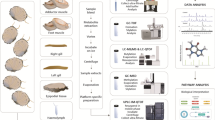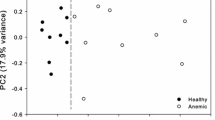Abstract
The crucian carp (Carassius carassius) can tolerate anoxia for days to months, depending on the temperature. In this study, we applied 1H-NMR-based metabolomics to polar extracts of crucian carp brain, heart, muscle and liver samples obtained from fish exposed to either control normoxic conditions, acute anoxia (24 h), chronic anoxia (1 week) or reoxygenation (for 1 week following chronic anoxia) at 5 °C. Spectra of the examined tissues revealed changes in several energy-related compounds. In particular, anoxic stress resulted in decreased concentrations of phosphocreatine (muscle, liver) and glycogen (liver) and ATP/ADP (liver, heart and muscle) and increased concentrations of lactate (brain, heart, muscle) and beta-hydroxybutyric acid (all tissues). Likewise, increased concentrations of inhibitory compounds (glycine, gamma-amino butyric acid or GABA) and decreased concentrations of excitatory metabolites (glutamate, glutamine) were confirmed in the anoxic brain extracts. Additionally, a decrease of N-acetylaspartate (NAA), an important neuronal marker, was also observed in anoxic brains. The branched-chain amino acids (BCAA) valine/isoleucine/leucine increased in all anoxic tissues. Possibly, this general tissue increase can be due to an inhibited mitochondrial function or due to protein degradation/protein synthesis inhibition. In this study, the potential and strength of the 1H-NMR is highlighted by the detection of previously unrecognized changes in metabolites. Specifically, myo-inositol substantially decreased in the heart of anoxic crucian carp and anoxic muscle tissue displayed a decreased concentration of taurine, providing novel insights into the anoxia responses of the crucian carp.




Similar content being viewed by others
References
Benjamini, Y., & Hochberg, Y. (1995). Controlling the false discovery rate: A practical and powerful approach to multiple testing. Journal of the Royal Statistical Society-Series B (Methodological), 57(1), 289–300.
Bickler, P. E., & Buck, L. T. (2007). Hypoxia tolerance in reptiles, amphibians, and fishes: Life with variable oxygen availability. Annual Review of Physiology, 69, 145–170.
Cheng, L. L., Ma, M. J., Becerra, L., et al. (1997). Quantitative neuropathology by high resolution magic angle spinning proton magnetic resonance spectroscopy. Proceedings of the National Academy of Sciences of the United States of America, 94(12), 6408–6413.
Choi, J. K., Dedeoglu, A., & Jenkins, B. G. (2007). Application of MRS to mouse models of neurodegenerative illness. NMR in Biomedicine, 20, 216–237.
Coen, M., Lenz, E. M., Nicholson, J. K., et al. (2003). An integrated metabonomic investigation of acetaminophen toxicity in the mouse using NMR spectroscopy. Chemical Research in Toxicology, 16(3), 295–303.
Govindaraju, V., Young, K., & Maudsley, A. A. (2000). Proton NMR chemical shifts and coupling constants for brain metabolites. NMR in Biomedicine, 13(3), 129–153.
Hylland, P., & Nilsson, G. E. (1999). Extracellular levels of amino acid neurotransmitters during anoxia and forced energy deficiency in crucian carp brain. Brain Research, 823, 49–58.
Johansson, D., Nilsson, G. E., & Doving, K. B. (1997). Anoxic depression of light-evoked potentials in retina and optic tectum of crucian carp. Neuroscience Letters, 237(2–3), 73–76.
Kohavi, R. (1995). A study of cross-validation and bootstrap for accuracy estimation and model selection. Proceedings of the Fourteenth International Joint Conference on Artificial Intelligence, 2, 1137–1143.
Kullgren, A., Samuelsson, L. M., Forlin, L., et al. (2010). A metabolomics approach to elucidate effects of food deprivation in juvenile rainbow trout (Oncorhynchus mykiss). American Journal of Physiology-Regulatory Integrative and Comparative Physiology, 299(6), R1440–R1448.
Kuzmina, V. V., Gavrovskaya, L. K., & Ryzhova, O. V. (2010). Taurine. Effect on exotrophia and metabolism in mammals and fish. Journal of Evolutionary Biochemistry and Physiology, 46(1), 19–27.
Lin, C. Y., Wu, H. F., Tjeerdema, R. S., & Viant, M. R. (2007). Evaluation of metabolite extraction strategies from tissue samples using NMR metabolomics. Metabolomics, 3(1), 55–67.
Lindon, J. C., Nicholson, J. K., & Everett, J. R. (1999). NMR spectroscopy of biofluids. Annual Reports on NMR Spectroscopy, 38, 1–88.
Lindon, J. C., Nicholson, J. K., & Holmes, E. (2007). The handbook of metabonomics and metabolomics (1st ed.). Amsterdam: Elsevier.
Lutz, P. L., & Nilsson, G. E. (1997). Contrasting strategies for anoxic brain survival: Glycolysis up or down. Journal of Experimental Biology, 200, 411–419.
Lutz, P. L., Nilsson, G. E., & Prentice, H. M. (2003). The brain without oxygen causes of failure-physiological and molecular mechanisms for survival. Mechanisms of Brain Anoxia Tolerance (3rd ed.) (pp. 131–189). The Netherlands: Kluwer Academic Publishers.
Mandic, M., Lau, G. Y., Nijjar, M. M. S., & Richards, J. G. (2008). Metabolic recovery in goldfish: A comparison of recovery from severe hypoxia exposure and exhaustive exercise. Comparative Biochemistry and Physiology, Part C, 148, 332–338.
Nilsson, G. E. (1988). A comparative study of aldehyde dehydrogenase and alcohol dehydrogenase activity in crucian carp and three other vertebrates: Apparent adaptations to ethanol production. Journal of Comparative Physiology B, 158, 479–485.
Nilsson, G. E. (1990). Long term anoxia in crucian carp: Changes in the levels of amino acid and monoamine neurotransmitters in the brain, catecholamines in chromaffin tissue, and liver glycogen. Journal of Experimental Biology, 150, 295–320.
Nilsson, G. E., & Lutz, P. L. (1991). Release of inhibitory neurotransmitters in response to anoxia in turtle brain. American Journal of Physiology, 261(1), R32–R37.
Nilsson, G. E., & Lutz, P. L. (2004). Anoxia tolerant brains. Journal of Cerebral Blood Flow and Metabolism, 24(5), 475–486.
Nilsson, G. E., Lutz, P. L., & Jackson, T. L. (1991). Neurotransmittors and anoxic survival of the brain: A comparison between anoxia-tolerant and anoxia-intolerant vertebrates. Journal of Physiological Zoology, 64, 638–652.
Podrabsky, J. E., Lopez, J. P., Fan, T. W. M., Higashi, R., & Somero, G. N. (2007). Extreme anoxia tolerance in embryos of the annual killifish Austrofundulus limnaeus: Insights from a metabolomics analysis. Journal of Experimental Biology, 210(13), 2253–2266.
Raman, L., Tkac, I., Ennis, K., et al. (2005). In vivo effect of chronic hypoxia on the neurochemical profile of the developing rat hippocampus. Developmental Brain Research, 156(2), 202–209.
Schaffer, S. W., Jong, C. J., Ramila, K. C., & Azuma, J. (2010). Physiological roles of taurine in heart and muscle. Journal of Biomedical Science, 17(1), 1–8.
Shoubridge, E. A., & Hochachka, P. W. (1980). Ethanol: Novel end product of vertebrate anaerobic metabolism. Science, 209(4453), 308–309.
Stecyk, J. A. W., & Farrell, A. P. (2002). Cardiorespiratory responses of the common carp (Cyprinus carpio) to severe hypoxia at three acclimation temperatures. Journal of Experimental Biology, 205(6), 759–768.
Stecyk, J. A. W., Stensløkken, K.-O., Farrell, A. P., & Nilsson, G. E. (2004). Maintained cardiac pumping in anoxic crucian carp. Science, 306, 77.
Stentiford, G. D., Viant, M. R., Ward, D. G., et al. (2005). Liver tumors in wild flatfish: A histopathological, proteomic, and metabolomic study. OMICS: A Journal of Integrative Biology, 9(3), 281–299.
Van Waarde, A., Van den Thillart, G., & Dobbe, F. (1982). Anaerobic metabolism of goldfish, Carassius auratus (L.). Influence of anoxia on mass-action ratios of transaminase reactions and levels of ammonia and succinate. Journal of Comparative Physiology B-Biochemical, Systemic, and Environmental, Physiology, 147(1), 53–59.
Van Waversveld, J., Addink, A. D. F., & van den Thillart, G. (1989). Simultaneous direct and indirect calorimetry on normoxic and anoxic goldfish. Journal of Experimental Biology, 142, 325–335.
Voet, D., & Voet, J. G. (1995). Biochemistry (Vol. 2). New York: Wiley.
Vornanen, M., Asikainen, J., & Haverinen, J. (2011). Body mass dependence of glycogen stores in the anoxia-tolerant crucian carp (Carassius carassius L.). Naturwissenschaften, 98, 225–232.
Vornanen, M., & Paajanen, V. (2006). Seasonal changes in glycogen content and Na+-K+-ATPase activity in the brain of crucian carp. American Journal of Physiology: Regulatory, Integrative and Comparative Physiology, 291, 1482–1489.
Vornanen, M., Stecyk, J. A. W., & Nilsson, G. E. (2009). The anoxia-tolerant crucian carp (Carassius carassius L.). Fish Physiology, 27, 397–441.
Vu, T. N., Valkenborg, D., Smets, K., Verwaest, K., Dommisse, R., Lemiere, F., et al. (2011). An integrated workflow for robust alignment and simplified quantitative analysis of NMR spectrometry data. BMC Bioinformatics, 12, 405.
Wang, Y., Haipeng, S., Lu, G., Ren, S., & Chen, J. (2011). Catabolism of branched-chain amino acids in heart failure: Insights from genetic models. Pediatric Cardiology, 32, 305–310.
Westerhuis, J. A., Hoefsloot, H. C. J., Smit, S., et al. (2008). Assessment of PLSDA cross validation. Metabolomics, 4(1), 81–89.
Wu, H. F., Southam, A. D., Hines, A., & Viant, M. R. (2008). High-throughput tissue extraction protocol for NMR and MS-based metabolomics. Journal of Analytical Biochemistry, 372(2), 204–212.
Acknowledgments
Isabelle Lardon and Trung Nghia Vu are funded by interdisciplinar scholarships of the University of Antwerp.
Author information
Authors and Affiliations
Corresponding author
Electronic supplementary material
Below is the link to the electronic supplementary material.
Rights and permissions
About this article
Cite this article
Lardon, I., Nilsson, G.E., Stecyk, J.A.W. et al. 1H-NMR study of the metabolome of an exceptionally anoxia tolerant vertebrate, the crucian carp (Carassius carassius). Metabolomics 9, 311–323 (2013). https://doi.org/10.1007/s11306-012-0448-y
Received:
Accepted:
Published:
Issue Date:
DOI: https://doi.org/10.1007/s11306-012-0448-y




